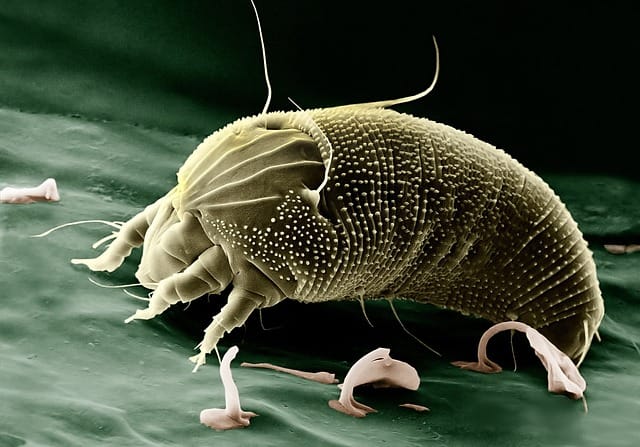Fighting gardening pests: Spider mites
Spider mites are tiny arachnids belonging to the Tetranychidae family that are notorious for causing damage to a wide variety of plants

In this article:
- Introduction to spider mites
- Identification of spider mites
- Understanding spider mite damage
- Life cycle of spider mites
- Common plants affected by spider mites
- Signs and symptoms of spider mite infestation
- Prevention techniques for spider mite control
- Natural methods to combat spider mites
- Chemical options for spider mite treatment
- Integrated pest management strategies for spider mites
- Steps to eliminate spider mites from your garden
- Monitoring and early detection of spider mite infestations
- Dealing with recurring spider mite problems
- Conclusion and final tips for spider mite management
Introduction to spider mites
Spider mites are tiny arachnids belonging to the Tetranychidae family that are notorious for causing damage to a wide variety of plants. They are commonly found in gardens and greenhouses, and their infestations can quickly spread and lead to significant plant health and yield losses.
Identification of spider mites
Spider mites are so small that they are often not visible to the naked eye. To identify them, you need to look for their characteristic webbing, which they use for protection and creating a suitable environment for reproduction. Additionally, spider mites can appear in various colors depending on the species and their life stage.
Understanding spider mite damage
Spider mites feed on the sap of plants, causing discoloration, wilting, and stunted growth. They puncture the cells to extract nutrients, which leads to the characteristic yellow spots and stippling on leaves. Over time, severe infestations can weaken and eventually kill plants.
Life cycle of spider mites
To effectively combat spider mites, it's crucial to understand their life cycle. They undergo several stages: egg, larva, nymph, and adult. Depending on environmental conditions, the life cycle can be as short as a week. This quick reproductive cycle makes spider mite populations grow rapidly.
Common plants affected by spider mites
Spider mites can infest a wide range of plants, but some are more susceptible than others. Common targets include tomatoes, cucumbers, peppers, roses, beans, strawberries, and many ornamental plants. Vigilance is essential if you grow these plants in your garden.
Signs and symptoms of spider mite infestation
Recognizing the signs and symptoms of spider mite infestation is crucial for early detection. Look out for yellowing leaves, fine webbing on the undersides of leaves, tiny moving dots (spider mites), stippling or speckling on leaves, and overall plant decline.
Prevention techniques for spider mite control
Preventing spider mite infestations is the first line of defense. Implementing techniques such as proper plant spacing, regular pruning, and promoting a healthy garden ecosystem can deter spider mites from settling in your garden in the first place.
Natural methods to combat spider mites
When dealing with spider mites, many gardeners prefer to use natural control methods. These can include introducing beneficial predators like ladybugs or lacewings, employing neem oil or insecticidal soap sprays, using reflective mulch, and practicing regular hose spraying to physically remove spider mites.
Chemical options for spider mite treatment
If natural methods fail to control spider mite populations, you may need to resort to chemical treatments. However, it's important to choose the least toxic option and always follow the instructions on the label carefully to avoid harming beneficial insects, animals, and the environment. Consider using miticides specifically formulated for spider mites.
Integrated pest management strategies for spider mites
Integrated pest management (IPM) is a holistic approach that combines preventive, cultural, biological, and chemical control methods. Implementing IPM strategies can effectively manage spider mites and other garden pests while minimizing environmental impacts.
Steps to eliminate spider mites from your garden
To eliminate spider mites from your garden, it's crucial to follow a systematic approach. This includes identifying and isolating infested plants, implementing appropriate control methods, monitoring the effectiveness of treatment, and maintaining the health and resilience of your garden in the long term.
Monitoring and early detection of spider mite infestations
Regular monitoring of your plants is key to catching spider mite infestations early on. Inspect the undersides of leaves, observe plant behavior, and be alert to any signs of damage. Early detection allows for prompt action, preventing the infestation from spreading further.
Dealing with recurring spider mite problems
In some cases, spider mites may return to your garden despite your best efforts. Addressing recurring spider mite problems requires a combination of different control methods, persistence, and continuous monitoring. Don't get discouraged and stay vigilant.
Conclusion and final tips for spider mite management
Successfully managing spider mites can be challenging, but with the right knowledge and proactive measures, you can minimize their impact on your garden. Remember to start with prevention, explore natural methods first, resort to chemicals only when necessary, and embrace integrated pest management for long-term success.
